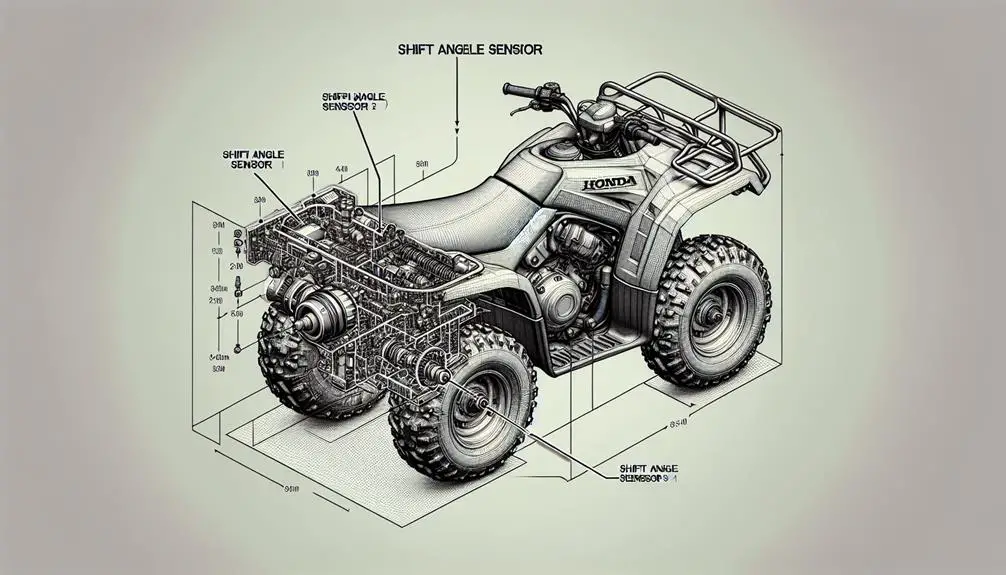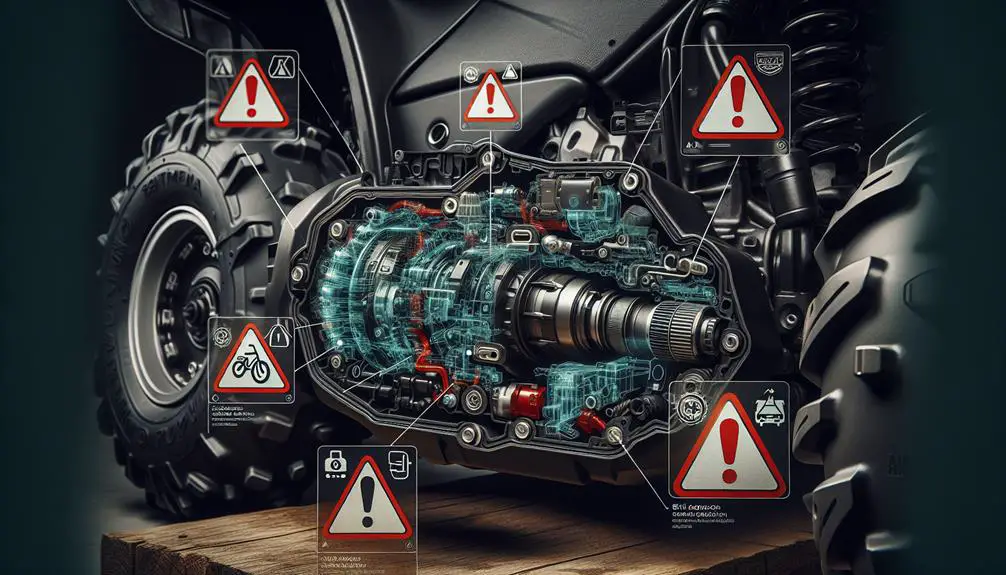The shift angle sensor is a device that detects the position of the shift drum and sends a signal to the ECM. It is located on the front/lower/center of the motor, beside the shift motor and under a small tin shield. To access it, you will need to remove the seat and some of the plastics.
What is a Shift Angle Sensor?

A Shift Angle Sensor (SAS) is crucial for the electronic shifting system in a Honda Foreman 500, enabling smooth gear shifts and optimal performance.
It communicates the gear position to the Engine Control Unit (ECU), affecting ignition timing and fuel injection for efficiency and performance.
Additionally, it contributes to engine protection by managing the rev limiter and engine braking, preventing over-revving. Maintaining the SAS is essential for the ATV’s functionality and rider’s safety.
Symptoms of a Faulty Shift Angle Sensor in Honda Foreman 500

Here are three main issues indicating a problem with the Shift Angle Sensor:
- Shifting Gears is Hard: Shifting between gears becomes difficult. It might feel like the gears are stuck and need extra force or many tries to shift. This means something is wrong inside.
- Gear Indicator is Off: The gear indicator on your dashboard might show wrong or changing readings. This happens because the broken sensor sends wrong signals to the ATV’s computer, confusing it about the gear position.
- Engine Acts Up: The engine might stall or act strangely when shifting gears. This is because the ECU gets wrong gear position information, messing up fuel injection and ignition timing.
These issues can make riding worse and cause bigger problems if not fixed. Noticing these signs early can help you save time and money and keep your Foreman 500 working well.
Honda Foreman 500 Shift Angle Sensor Location

The Shift Angle Sensor on a Honda Foreman 500 is found on the left side of the engine, near the gear shifter’s bottom. It’s a small, cylinder-shaped sensor that’s important for the ATV’s electronic shifting. It helps the Engine Control Unit (ECU) know the gear position, which is necessary for good engine performance and smooth riding.
Knowing where the Shift Angle Sensor is located is key to fixing any shifting problems like hard shifting, gear slipping, erratic shifts, wrong gear indication, or engine stalling. The sensor is connected to the engine with a wire harness and can be spotted easily in the correct location. You might need to remove parts like the footrest or shift lever assembly to reach it, depending on your ATV model.
Step-by-Step Guide to Accessing the Shift Angle Sensor

Step 1: Gather the necessary tools, including a socket wrench set, Phillips screwdriver, and some clean rags.
Step 2: Ensure the engine of your Honda Foreman 500 has cooled down to avoid any risk of burns.
Step 3: Park your Honda Foreman 500 on a level surface to ensure stability during the repair process.
Step 4: Disconnect the battery to prevent any electrical accidents while accessing the shift angle sensor.
Tools needed for the job
To access the Shift Angle Sensor on a Honda Foreman 500, you need:
- Socket Wrench Set: To unscrew the sensor’s bolts. Have different sizes ready.
- Phillips Screwdriver: To take apart parts blocking the sensor.
- Rags: For cleaning the sensor area from dirt or grease.
Ensure these tools are ready before starting to save time and improve efficiency.
Precautions and preparations
Before you start working on the Shift Angle Sensor of your Honda Foreman 500, ensure safety and proper setup. Follow these steps:
- Cool the Engine: Wait until the ATV’s engine is no longer hot to avoid burns.
- Secure Parking: Park on a flat area and apply the parking brake to keep the ATV from moving.
- Electrical Precaution: Unhook the negative battery cable to prevent electric shock or damaging the ATV’s electrical components.
Detailed steps to access the shift angle sensor
Step 1:
Gather all the necessary tools and ensure you take all safety precautions before starting the process of accessing the shift angle sensor on your Honda Foreman 500.
Step 2:
Using a socket wrench set, remove the mounting bolts from the sensor. This will allow you to access the sensor itself.
Step 3:
Next, take a Phillips screwdriver and disconnect the electrical connector. This step is crucial for safely removing the sensor without causing damage to the electrical system.
Step 4:
With a rag, clean the area around the sensor. This is important to avoid any debris from getting into the engine case once the sensor is removed.
Step 5:
After the electrical connector has been safely disconnected, unscrew the mounting bolts that you loosened in step 2. With the bolts completely removed, you can now gently take out the sensor.
Remember to keep the work area clean and organized throughout the process to ensure that replacing or inspecting the sensor is hassle-free.
Testing the Shift Angle Sensor in Honda Foreman 500

To check the Shift Angle Sensor on a Honda Foreman 500, follow these steps:
- Prepare Tools: Get a multimeter to measure the sensor’s electrical properties. Set it to the right scale.
- Find the Sensor: The Shift Angle Sensor is on the left side of the engine case. Make sure it’s easy to reach by having previously disconnected its electrical connector and removing any blocking parts.
- Test the Sensor: Use the multimeter probes to touch the sensor terminals. Look at the service manual for the expected resistance values. If the readings are off, the sensor might be damaged.
Replacing a Faulty Shift Angle Sensor

If your Shift Angle Sensor is bad after testing, you can replace it yourself. First, buy a quality shift angle sensor for your Honda Foreman 500.
Ensure the ATV engine is cool and parked on a flat surface. Disconnect the ATV’s negative battery terminal for safety. Find the shift angle sensor on the engine case’s left side, below the gear shifter. You might need to remove parts like the footrest or shift lever for better access.
Disconnect the sensor’s electrical connector. Use a socket wrench to remove the sensor’s mounting bolts and take out the old sensor. Put in the new sensor, make sure it’s in the right position, and reattach everything in reverse order. Tighten the bolts to the right tightness.
Troubleshooting Common Shift Angle Sensor Problems in Honda Foreman 500

Here are steps to fix common sensor issues, so your gears shift smoothly again.
Check the Electrical Connection
- First, ensure the sensor’s electrical connector is correctly connected and not corroded. A bad connection can interrupt signals to the ECU, causing shifting issues. This simple check can prevent bigger problems.
Inspect the Wiring Harness
- Look at the wiring harness for damage, like frays or cuts. Damaged wires can cause inconsistent or wrong signals, disrupting the shifting. If you find damage, repair or replace the wires.
Clean the Sensor Contacts
- Clean the sensor contacts. Dirt, debris, or moisture can affect the sensor’s performance. Use electrical contact cleaner to clean off any dirt, ensuring signals can transmit clearly.
Wrapping Up
Keeping your Honda Foreman 500’s Shift Angle Sensor (SAS) working right is very important for smooth gear changes. If your gear shifts are acting weird or the indicators aren’t showing right, you should check the SAS.
You’ll find it on the left side, close to where the gears change. To make sure your ATV works well, you can follow steps to look at, test, and maybe even change the sensor if needed.
This small part is really important for making sure your ATV shifts gears smoothly, so don’t ignore it if you’re having trouble with shifting.
